Introduction
The Royal Commission of Inquiry into the Condition of Crofters and Cottars in the Highlands and Islands was a public inquiry held in response to land agitation in the Highlands and Islands. This inquiry is more commonly referred to as the Napier Commission.
On 17 March 1883, six men were appointed to the commission by the then-Home Secretary Sir William Harcourt of the Liberal Government:
- Lord Francis Napier of Ettrick (1819-1898), 10th Lord Napier of Merchistoun and first Baron Ettrick. Chairman of the commission, a landowner in the Borders and retired diplomat.
- Sir Kenneth Mackenzie, 6th Baronet and 13th Laird of Gairloch. A landowner.
- Donald Cameron of Lochiel, M.P. for Inverness-shire. A landowner and diplomat.
- Charles Fraser-Mackintosh (1828-1901), M.P. for Inverness burghs and landowner.
- Sheriff Alexander Nicolson (1827-1893), Sheriff-substitute and Gaelic scholar, a native of Skye.
- Professor Donald MacKinnon (1839-1914), the first Professor of Celtic at the University of Edinburgh.
- Malcolm MacNeill, the Commission Secretary.
During the second half of the 18th and 19th centuries many landlords tried to make their estates more profitable by converting the traditional system of working the land in small plots into larger units, for which they could charge a higher price. This was part of a general process of agricultural modernisation. Many of the larger holdings were let to sheep farmers, and former tenants were evicted from the land that they and their families had worked for generations.
The tenants that were evicted were not guaranteed an equivalent plot of land. Instead, they would often be transported to smaller, less fertile crofts. These evictions as a result of agricultural changes became known as the ‘Highland Clearances’.
Definitions
- Croft – a ‘Croft’ is a term frequently used in Scotland to describe a small farm, or piece of land that is worked by the tenant.
- Crofter – an owner or tenant of a small farm, especially in Scotland or northern England.
- Cottar – a tenant on a farm who occupies a cottage, with or without a piece of land attached, in return for their labour.
- The Napier Commission defined in their final report a crofter and cottar – “For the purposes of this inquiry and report we limit the class of crofters to tenants paying not more than £30 annual rent, but we are unable to fix any point in rental below which the crofter descends into the cottar class.”
The increase in population in the 19th century, combined with the Clearances, caused severe overcrowding in some areas. Alongside a decline in the kelp industry, the fall in the price of livestock and a reduction in seasonal work, came the loss of cash incomes and a greater dependence on the land.
These social and economic changes precipitated a series of disputes between landlords, the authorities and crofting communities. In the early 1880s, the simmering discontent long felt by the crofters at their shortage of land boiled over. Overcrowded areas where tenants had been moved to were often bordered by large and fertile areas used for sheep farms and deer forests. Rent strikes and seizures of land began on Skye and spread throughout the crofting counties. Sheriff officers serving eviction notices for non-payment of rent were assaulted. The subsequent arrest of five crofters from the Braes district of Skye for this offence resulted in the “Battle of the Braes” (see ‘Further reading’) on 7 April 1882.
The unrest in the Highlands and Islands brought the crofter’s grievances to the attention of the public and of the parliament. The Commission, set up under Lord Napier, toured the crofting counties hearing evidence from crofters. The tour lasted five months, and included 71 meetings in 61 locations across the Highlands. 775 people spoke including crofters, factors and landowners. The Commission’s report was published in April 1884. Its recommendations included:
- Fair rents
- Compensation for improvements made by crofters to their holdings
- Security of tenure for those whose annual rent was £6 or more who undertook to improve their crofts
- The granting of legal status to crofting townships
Two years after the Napier Commission’s report, the first Crofter’s Act was passed. The Crofters’ Holdings (Scotland) Act became law on 25 June 1886.
What records are available on Scotland's People?
National Records of Scotland (hereafter NRS) holds records of returns gathered by the Royal Commission of Inquiry into the Conditions of Crofters and Cottars in the Highlands and Islands (The Napier Commission) in 1883. These are found under the NRS archive catalogue reference AF50.
The returns are arranged by county, and the number of volumes for each county varies. They can give an individual’s name, designation, occupation/means of subsistence, county, estate, proprietor, and location. The entries are organised by estate, and the parish and township can often be found at the top of the page.
These records are available to view on Scotland’s People. Included in this collection are:
- AF50/6: Returns by proprietors or factors of estates in the counties of Argyll, Caithness, Inverness, Ross and Cromarty, and Sutherland giving: rentals and areas of deer forest, farms, crofters' holdings, shootings, fishings and house property for the years 1853 and 1883.
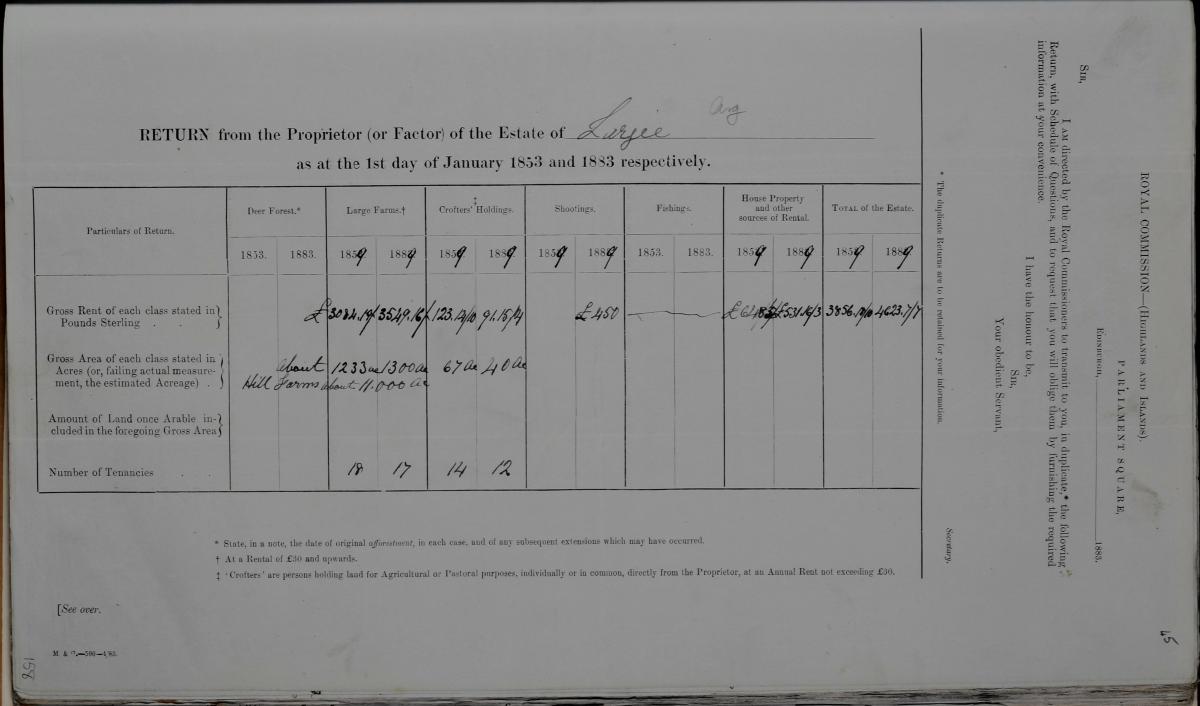
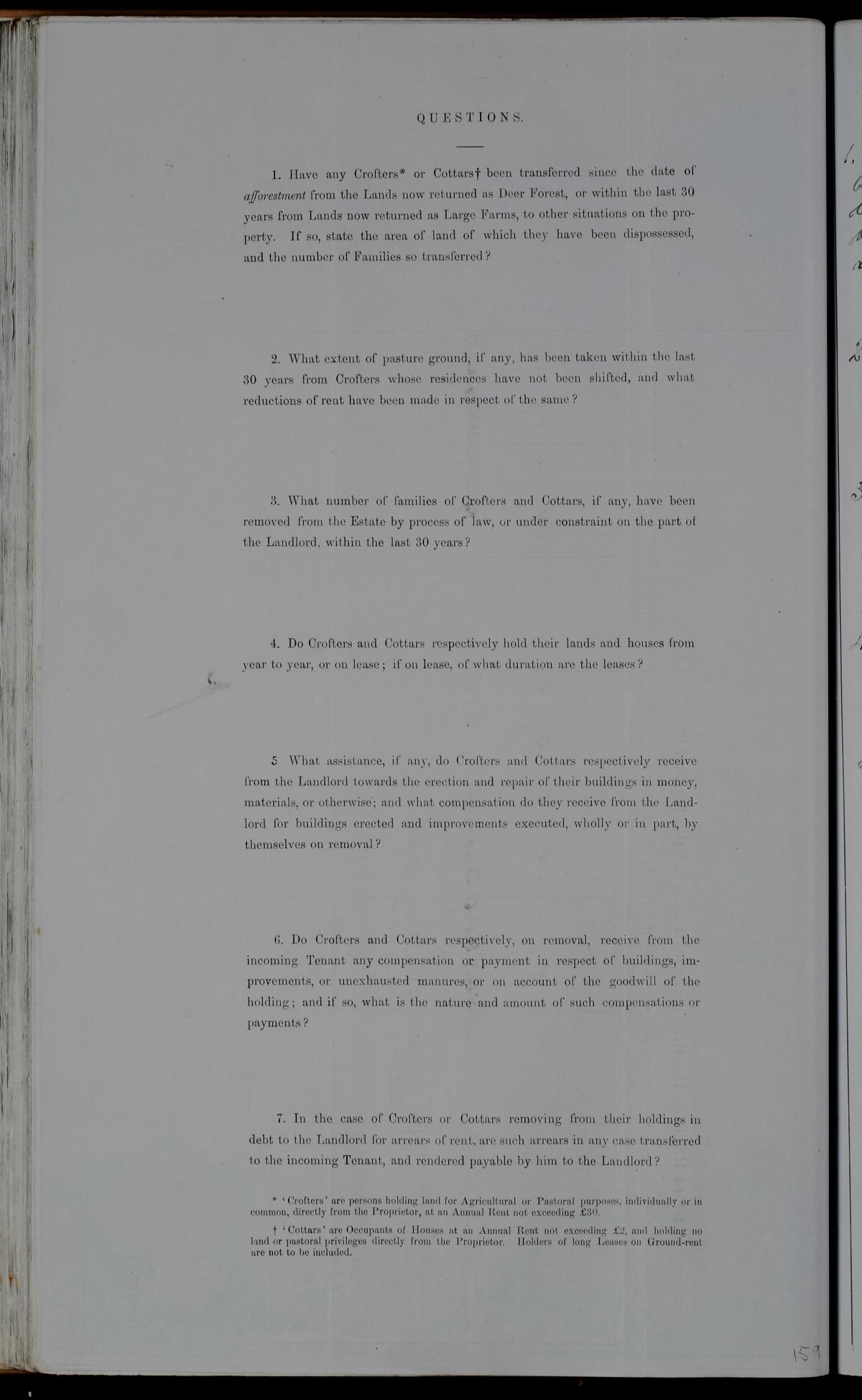
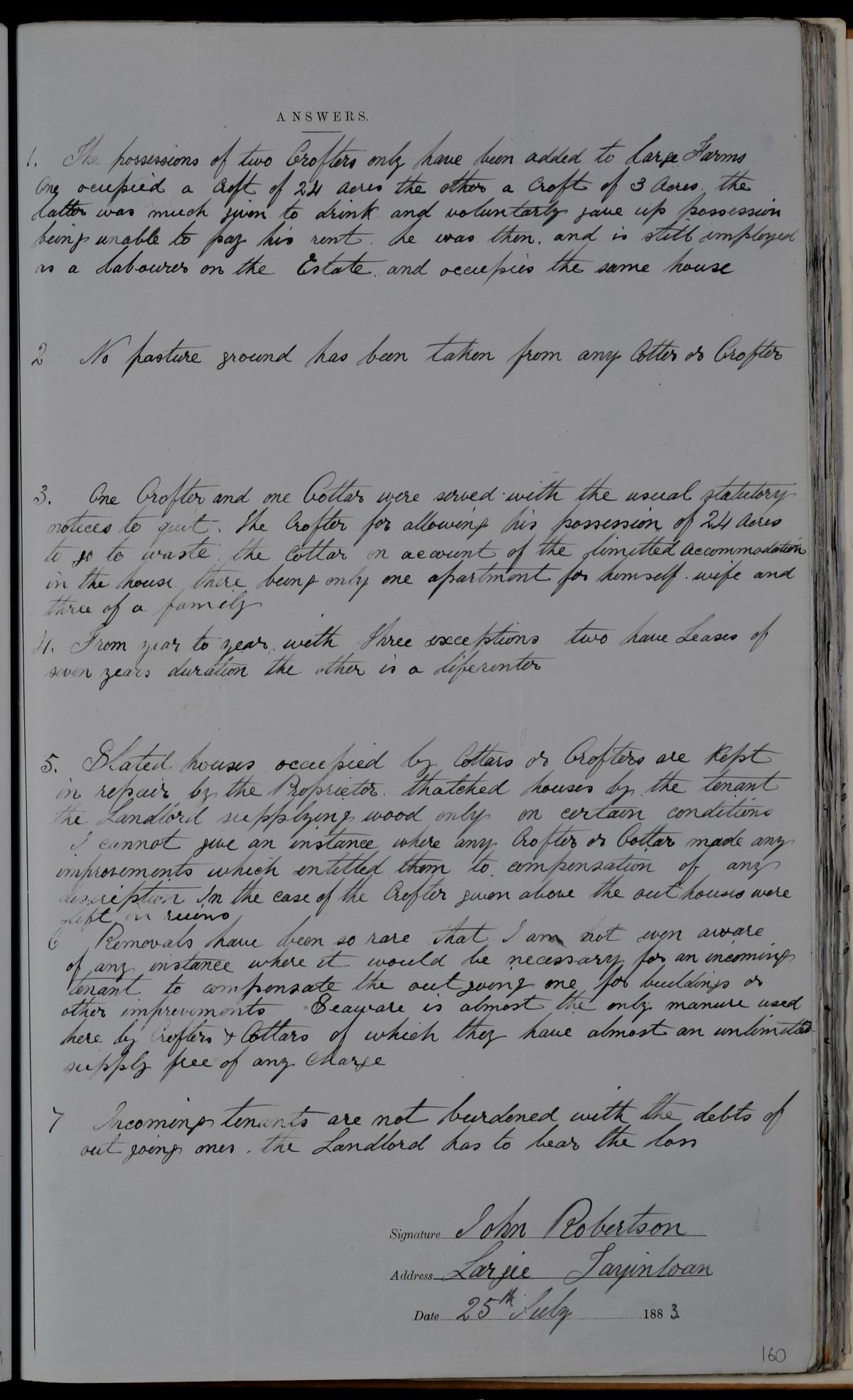
- AF50/7: Returns by proprietors or factors of estates in the county of Argyll respecting crofters and cottars. These include information such as the names of crofters/cottars, the number of families and dwellings, their rent, obligations in labour or service, the extent of holdings, arable, pasture and stock.
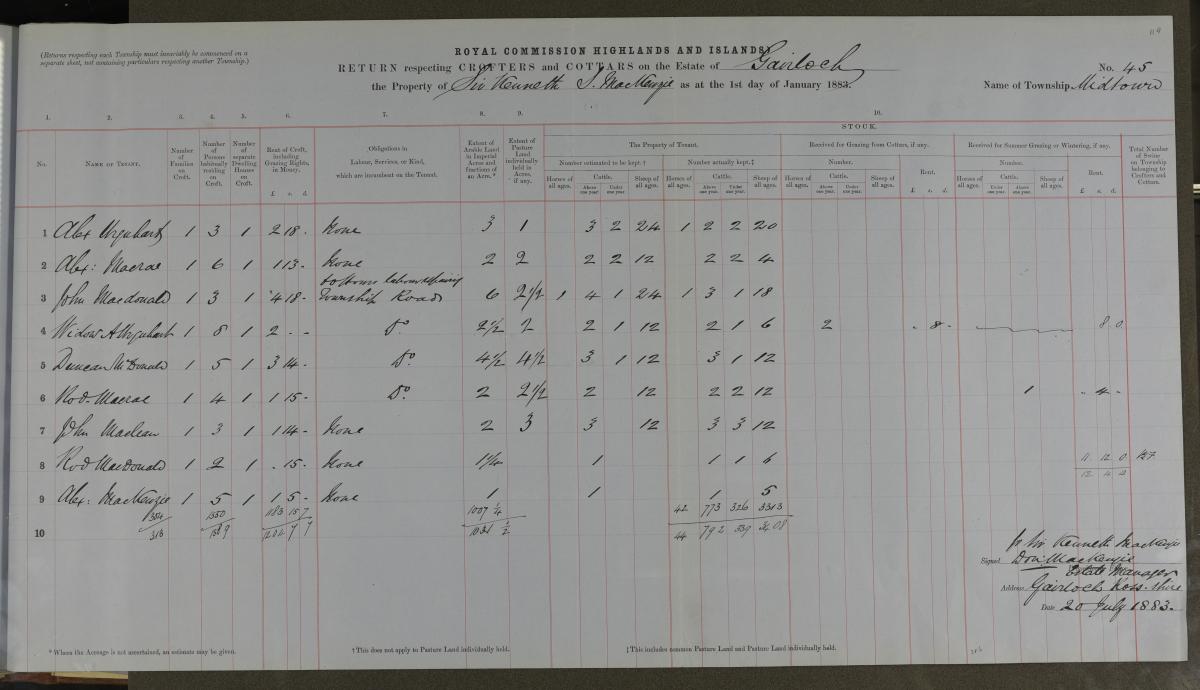
- AF50/8: Returns by proprietors or factors of estates in the counties of Argyll, Caithness, Inverness, Ross and Cromarty, and Sutherland giving: names of cottars, whether they are resident on a croft or not, what their rent was and who it was paid to, and their occupation or other means of subsistence.
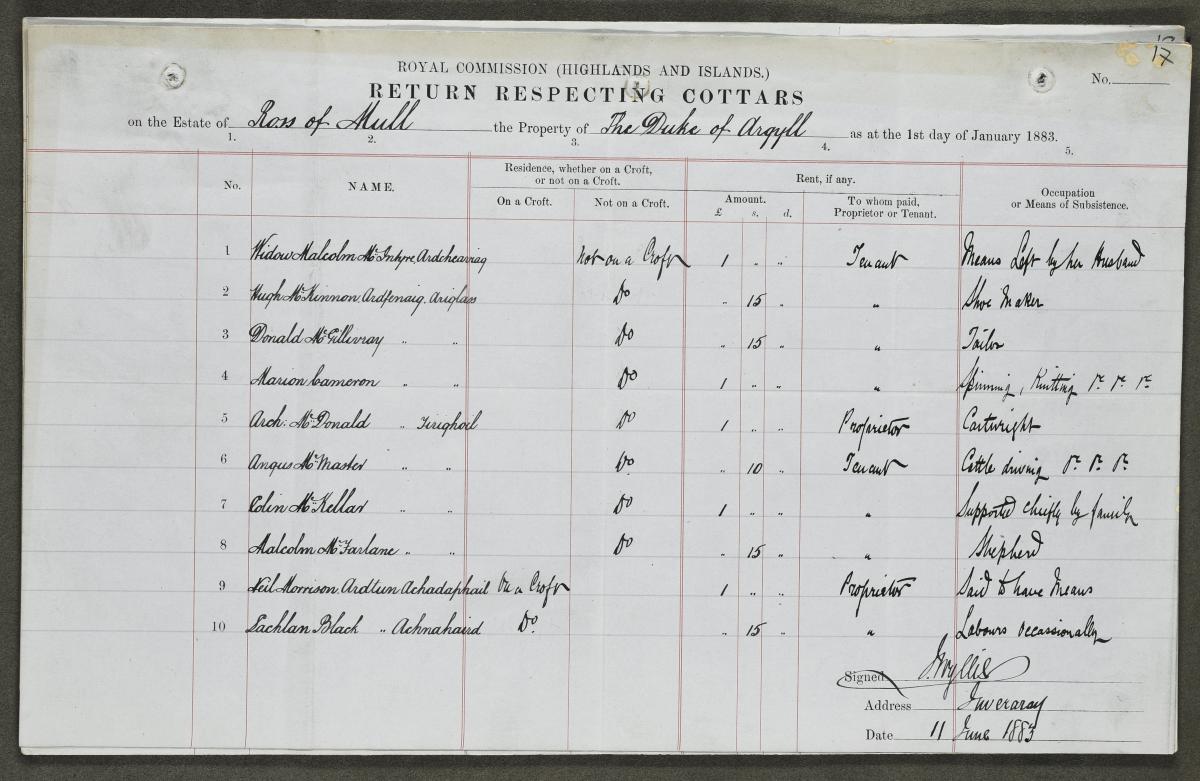
The returns (AF50/6, AF50/7 and AF50/8) are free to browse via the ‘Volume search’ in the Virtual Volumes area.
AF50/7 and AF50/8 have been indexed, creating over 16,000 searchable entries viewable in the dedicated Crofters and Cottars (Napier Commission) search form.
Not all parishes in Argyll, Inverness and Ross and Cromarty counties are covered in the returns, e.g. Easter Ross. Orkney and Shetland were visited by the Commissioners, but NRS do not hold returns for these counties.
How to search
There are two ways to access the crofters and cottars returns. Firstly via the ‘Crofters and Cottars (Napier Commission)’ search page, which provides a searchable index. Secondly, the digital images are freely browsable in the Virtual Volumes area.
1.1 Search form
You can use the dedicated Crofters and Cottars (Napier Commission) search form in the ‘People’ search area to search and view over 16,000 entries. Searching is free and images of the original records can be viewed for a charge of two credits.
You can search the Crofters and Cottars returns using some or all of the following index fields:
- Surname
- Forename
- Gender
- County
- Parish
- Place (estate or township)
- Proprietor
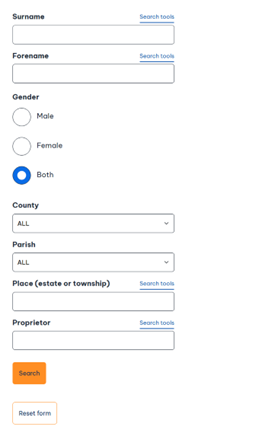
Names are captured as they are given on the returns. Reasons for a name not appearing as expected might include:
- Misspelling, phonetic spelling or other misinterpretation
- Surname variants
- Forename variations, including abbreviations, use of diminutives (for example, Alex for Alexander), nicknames or middle names as first names.
The original records do not record an individual’s gender. To assist searching, gender information has been added to the index. In a number of cases, it has been impossible to determine an individual's gender as the name is recorded as, for example, ‘A. Macdonald’ with no other identifying information. In this case, the gender has been recorded as ‘U’ for unknown.
The ‘Place (estate or township)’ search shows results where the search term is mentioned in the 'Estate' column or 'Name of Township' section of the returns, or where a local place name is written next to the name of a crofter or cottar.
For proprietors from noble families, their title might be recorded rather than their family name, e.g. The Duke of Sutherland rather than George Granville William Sutherland-Leveson-Gowe.
1.2 Results page
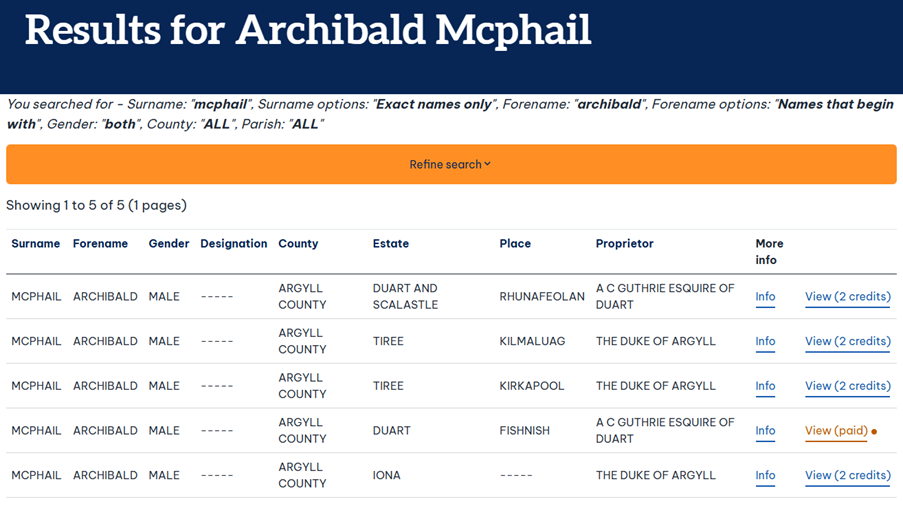
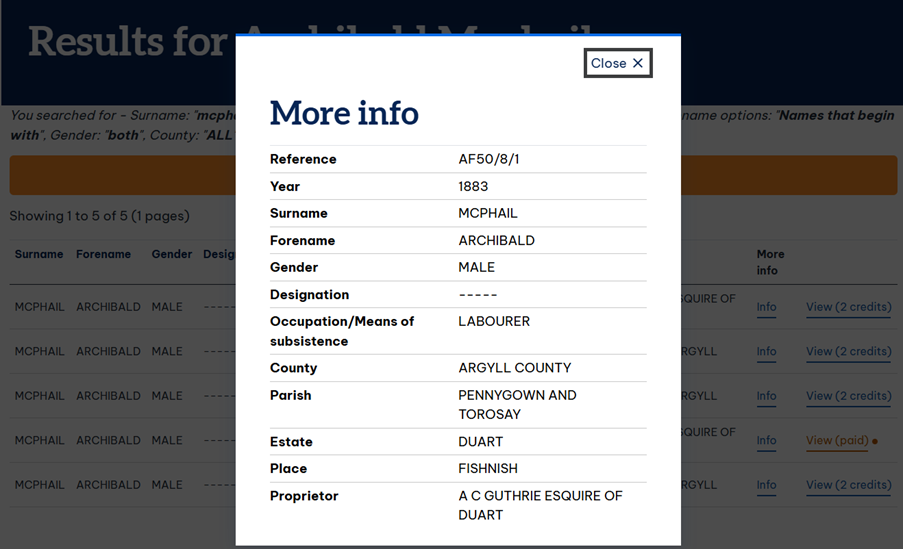
The results page shows the Surname, Forename, Gender, Designation, County, Estate, Place and Proprietor. You can click on ‘Info’ in the 'More info' column to view additional details.
1.3 Virtual Volumes
The returns are free to browse via the ‘Volume search’ in the Virtual Volumes area.
Select the ‘Royal commissions’ record category and then the ‘Napier Commission (1883)’ record type to search the records.
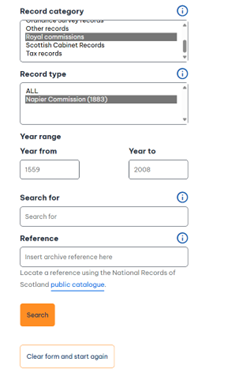
Our guide on using Virtual Volumes provides additional information on searching un-indexed records on Scotland’s People.
Understanding the content
The returns collected from landowners/estate factors were recorded on two types of form: one of these is used for returns with the NRS reference AF50/7 (crofters and cottars); the other is for AF50/8 (cottars only). The columns for most of these fields are self-explanatory from the column titles, but some further details are provided below for clarity.
Name of Township – the returns respecting crofters and cottars (NRS, AF50/7) record the ‘Name of Township’ in the top right corner of the page. The place names recorded here can be searched in the Place (estate or township) field on Scotland’s People. In a letter from the Commission to a landowner in Caithness (NRS, AF50/2, page 81) a ‘Township’ is defined as ‘[…] merely a District or Group of Crofter-holdings called by a separate name.’
Obligations in Labour, Services, or Kind, which are incumbent on the Tenant – duties required of tenants by the landowner. Examples include wall repair, maintenance of estate roads, works with horses and cart repairing.
Stock – Estimated to be kept – in the Stock columns, ‘Estimated to be kept’ refers to the number of livestock which the tenant is entitled to place on the common pasture of his township.
Stock – Number actually kept – ‘Number actually kept’ refers to the number of animals actually kept, in order to show whether the tenant exceeds or falls below the number of livestock he is entitled to, as defined in a letter sent by the Commission on 30 April 1883 (NRS, AF50/2, page 42).
Occupation or means of subsistence – the returns of named cottars (NRS, AF50/8) include a column for ‘Occupation or Means of Subsistence’ which includes means of living outside of crofting. Examples include fishing, knitting, support from family and parish relief.
Related records
NRS holds other archives relevant to researching crofters and the history of land clearances in the Highlands and Islands. The majority of records listed are accessible via NRS’ Historical Search Room.
Scottish Office Agriculture and Fisheries Department (AF)
Within the records of the Agriculture and Fisheries Department for Scotland (AF) there are a series of files relating to crofting under reference AF67. These files were raised in what was the Scottish Office and contain material relating to all aspects of the crofting counties.
See also the Royal Commission on Highlands and Islands (AF50), Emigration files (AF51), and Crofting Development files (AF81). AF42, records of the Congested Districts Board may also be of interest. Similar material can also be found in the Scottish Home and Health Department series HH1 and HH28.
The Highland Destitution papers (HD)
By the beginning of the 1840s, conditions in many parts of the Highlands and Islands were critical. Most of the population depended on the potato for food – the only crop capable of supporting a large population on small plots of land. The failure of the potato crop in 1846 and subsequent years caused widespread distress. A Board was set up to provide relief and meal in return for work.
For a full description of what these papers include, please see the NRS Online Catalogue. A small selection of these papers, those of the Highland and Island Emigration Society (HD/4) can be searched on Scotland’s People. The Highland and Island Emigration Society record guide provides further information about these records and how they can be searched.
The papers of Sheriff William Ivory (1825–1915) (GD1/36)
Admitted as an advocate in 1849 and appointed Sheriff of Inverness (later Inverness, Elgin and Nairn) in 1862, William Ivory held this office until 1900. Most of the records relate to crofting disturbances in Skye and the Outer Hebrides (1882–96).
Related records not held by NRS
An indexed copy of the Napier Commission report (1884) is available on the University of Highlands and Islands website. Alongside the index, the five volumes of testimonies gathered as part of the Napier Commission are digitised.
The Highland Archive Service may have further records of interest. To view the different Archive Centres and information about their collections, see the High Life Highland website.
Further reading
- The Scottish Clearances: a history of the dispossessed, TM Devine. Available in the NRS Library, ES 068.048
- The story of crofting in Scotland, Douglas Willis. Available in the NRS Library, ES 068.095
- Mightier than a lord: the Highland crofters’ struggle for the land, Iain Fraser Grigor. Available in the NRS Library, ES D068.150
- Battle of the Braes: an exhibition by Skye and Lochalsh Archive Centre, Battle of the Braes: an exhibition by Skye and Lochalsh Archive Centre - Archives Service
- Radical Books: The Napier Report, Andy Drummond. Radical Books: The Napier Report | History Workshop